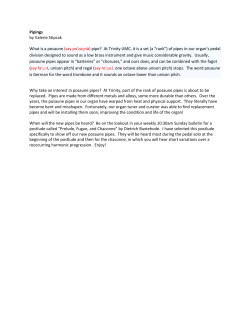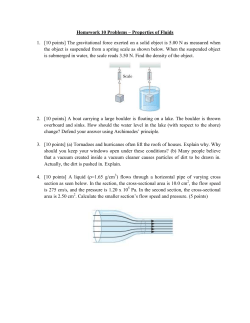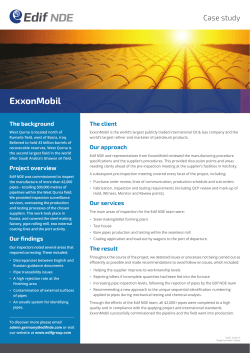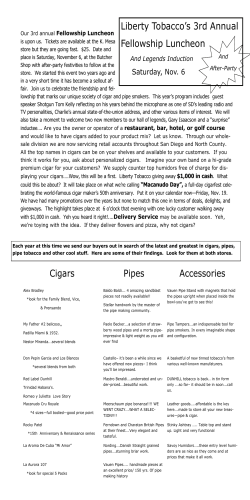
So Many Pipes to Inspect â So Which One`s First?
AMERICAN WATER WORKS ASSOCIATION NEW JERSEY SECTION 2015 Annual Conference So Many Pipes to Inspect – So Which One’s First? Brian F. Carr, P.E. Middlesex Water Company David J. Tanzi, P.E., BCEE CDM Smith Inc. March 19, 2015 Agenda • Introduction • Classic prioritization process • Risk-based prioritization approach – – – – – • • • • Probability of failure Prioritization process Scoring CapPlan Results Methods of condition assessment Development of capital plan Conclusions Questions So Many Pipes to Inspect – So Which One’s First? Middlesex Water Company – Background • 118-year-old, NASDAQ-listed company • Provides water, wastewater, and related utility services in central New Jersey and Delaware • Serves a population of more than 400,000 • ~40 miles of trunk mains • ~700 miles of distribution main So Many Pipes to Inspect – So Which One’s First? Middlesex Water Company – Background • Already embarked on a 20 year plan • $50M over that time in pipe renewal • Average of 5.8 miles of small diameter main renewed each year • Focus attention on large diameter mains • Unsure of: – Type of condition assessment to perform – What and when to inspect • Needed to develop a long-range, risk-based plan • Desired a condition assessment program to: – Manage it over time as needs change – Assist in capital budget planning So Many Pipes to Inspect – So Which One’s First? 30-inch and Greater Diameter PCCP Transmission Mains • 70,500 LF of 30-inch installed between 1949 and 1990 • 11,600 LF of 36-inch installed between 1965 and 1969 • 19,000 LF of 42-inch installed in 1990 • 24,500 LF of 48-inch installed between 1965 and 1969 So Many Pipes to Inspect – So Which One’s First? CLASSIC PRIORITIZATION PROCESS Triage For Water Main Condition Assessment • Merriam Webster Defines Triage: the assigning of priority order to projects on the basis of where funds and other resources can be best used, are most needed, or are most likely to achieve success Highest Ranked Assets Based on Risk High Risk Assets with Uncertain Condition or Limits So Many Pipes to Inspect – So Which One’s First? Survey Level CA Advanced CA Classic Process for Prioritization • Requires assumptions – Service life of assets – Which factors affect asset life and by how much? • Linear process Assumptions Capital Plans – Limited feedback – Minimal guidance on future data collection • Not integrated into the enterprise – Lack of dedicated capital planning software Information Collection Processing Tools So Many Pipes to Inspect – So Which One’s First? Outputs Classic Tools for Prioritization • Legacy employees – People with vast knowledge of the system and where the problems are • Paper mapping, or individual systems – Replace based on age or individual statistics – Tracking of main breaks – Customer complaints • These are not sustainable and not integrated into the enterprise – Lack of feedback and not detailed capital planning So Many Pipes to Inspect – So Which One’s First? Defensible Capital Planning Framework • Change in capital planning direction – – – – – Easy work has been done – now what? Where does a system stand in its “asset life”? How much do we need to replace? How do we reduce consequence of failure over time? Leverage GIS and hydraulic model investment • What are the tools to support this? • Goals: – – – – Asset inventory Prioritization of the inventory Defensible Plan for inspection So Many Pipes to Inspect – So Which One’s First? RISK-BASED PRIORITIZATION APPROACH New Tools for Prioritization – A Good Base Hydraulic Model Computerized Maintenance Management Systems (CMMS) So Many Pipes to Inspect – So Which One’s First? Microsoft Excel Geographic Information Systems (GIS) The Long-Term, Risk-Based Approach • Capital planning process is no longer linear – Building upon GIS, hydraulic models, etc. GIS Data – Continuous feedback • Includes: Anecdotal Data Hydraulic Model – Long-term budget Field Samples needs analysis O&M Data – Ranking assets for renewal based on risk – Electronic decision Decision Support support tools Tools Capital Plan So Many Pipes to Inspect – So Which One’s First? KANEW LEYP Defensible & Sustainable Capital Planning Innovyze CapPlan GIS Processing Probability of Failure RISK-BASED PRIORITIZATION APPROACH Risk-Based Asset Ranking Factors for MWCo • Probability of failure • Consequence of failure • Multiple workshops with project stakeholders – Engineering – Distribution – Operations • • • • Dependent on existing data Analysis fed by GIS and model Defensible Industry driven So Many Pipes to Inspect – So Which One’s First? Probability of Failure Factors - Initial Bury depth Earthquake / earth shift Electrical transmission lines Joint types Type of lining Major roadways Manufacturing issues Model C-Value – proxy for condition • Number of connections • • • • • • • • So Many Pipes to Inspect – So Which One’s First? • Past breaks/leaks/service history issues • Pipe age or vintage • Pipe wrapping • Pressure • Pressure fluctuation • Railway crossing • Soil resistivity • Water age • Water hammer/transients Data Sources • MWCo GIS database – Location of valves, blow-offs, AVRV’s • As-built drawings – Plan and profile • Cut-sheets – PCCP design criteria • Hydraulic model – Historical, current and future operating pressures • Soil types – MWCo known issues • Known pipeline issues – Past break locations So Many Pipes to Inspect – So Which One’s First? Probability of Failure Factors - Removed • Earthquake / earth shift – Lack of applicability • Type of lining – All pipe has CML • Model C-Value - proxy for condition – C-values did not vary significantly So Many Pipes to Inspect – So Which One’s First? • Pipe wrapping – Lack of information • Water age – Not significant variation Probability of Failure Factors - Final • • • • • • Bury depth Electrical transmission lines Joint types Major roadways Manufacturing issues Number of connections So Many Pipes to Inspect – So Which One’s First? • Past breaks/leaks/service history issues • Pipe age or vintage • Pressure • Pressure fluctuation • Railway crossing • Soil resistivity • Water hammer/transients Prioritization Process RISK-BASED PRIORITIZATION APPROACH Overview of Prioritization Process • Weighting values – 1 (negligible) to 5 (extreme) – Table 2-2 per kickoff workshop • Scoring ranges – Range of scores developed for each factor: 0 (lowest) to 5 (highest) – Applied to differentiate scores based on severity – Developed by Project Team • Exponent – Exponential factors can be used to increase the score of specific factors – No exponents were applied (value set to 1) So Many Pipes to Inspect – So Which One’s First? Scoring RISK-BASED PRIORITIZATION APPROACH Failure Risk Factor: Joint Types Factor Description Factor Weighting Value Factor Scoring Range Bolted Bell (5) Certain joint types are more susceptible to failure than other joint types. Welded (3) 2 Harnessed (2) Restrained (2) Bell and Spigot/Unknown (0) So Many Pipes to Inspect – So Which One’s First? Failure Risk Factor: Joint Types • Source: – Record drawings and lay schedules – MWCo GIS database • Data processing methodology – Known restrained joint types receive a higher score for potential failure. – Unknown joint types and unrestrained bell and spigot joints receive a lower score for potential failure. So Many Pipes to Inspect – So Which One’s First? Failure Risk Factor: Major Roadways Factor Description Factor Weighting Value Larger, more traveled roadways generally have more salt applied to them and have more traffic load causing potential pipe corrosion or harm. Major roadways are defined as US Route, Interstate, Toll Route, Ramp, State and County roadways. So Many Pipes to Inspect – So Which One’s First? 1 Factor Scoring Range Within 40-ft of Major Roadway (5) Not Within 40-ft of Major Roadway (0) Failure Risk Factor: Major Roadways • Source: – MWCo GIS database • Data processing methodology – Pipes that cross over or run parallel to major streets – 40 feet buffer on either side of centerline of major street – Pipes within buffer receive a higher score for potential failure So Many Pipes to Inspect – So Which One’s First? Failure Risk Factor: Pressure Fluctuation Factor Description Factor Weighting Value Factor Scoring Range Fluctuations Greater than 16 psi (5) Large, daily average pressure fluctuations in a pipeline can weaken a pipe over time. Fluctuations 12 to 16 psi (4) 3.5 Fluctuations 9 to 12 psi (3) Fluctuations 2 to 9 psi (2) Fluctuations less than 2 psi (0) So Many Pipes to Inspect – So Which One’s First? Failure Risk Factor: Pressure Fluctuation • Source: – MWCo hydraulic model • Data processing methodology – Pipe segments with larger fluctuations in pressure receive a higher score for potential failure due to the potential for large, daily average pressure fluctuations to weaken a pipe over time. So Many Pipes to Inspect – So Which One’s First? CapPlan RISK-BASED PRIORITIZATION APPROACH Leveraging CapPlan: Setting up the Condition Factors • Software reads GIS and modeling data • Build tests based on spatial analysis, physical attributes, failure history, etc. • Easy to use interface – Select type of test – Select attributes to rank on – Can select model scenario to run So Many Pipes to Inspect – So Which One’s First? Results RISK-BASED PRIORITIZATION APPROACH Probability of Failure Analysis Results So Many Pipes to Inspect – So Which One’s First? Probability of Failure Analysis Results • Total aggregate probability of failure score for each PCCP segment • Scores ranged from 25 to 109 • Red: high probability • Dark Blue: low probability So Many Pipes to Inspect – So Which One’s First? METHODS FOR CONDITION ASSESSMENTS Methods for Condition Assessments Pipe Condition Assessment Technologies • • • • • • • • • Electromagnetics (EM) testing Internal visual inspection (CCTV) Sonar and laser scanning inspection Sonic/ultrasonic/impact echo testing Acoustic pulse testing Pipe wall soundings and wire investigation External inspection with soil and groundwater testing Coupons or sampling Air Release Valve (ARV) inspection So Many Pipes to Inspect – So Which One’s First? Condition Assessment Toolbox This image cannot currently be display ed. So Many Pipes to Inspect – So Which One’s First? Methods for Condition Assessments Pipe Out of Service Assessment Methods • • • • Electromagnetics testing Internal visual inspection Sonic/ultrasonic/impact echo testing Coupons or sampling Leak Detection Technologies • • • • • Internal visual inspection with hydrophone Free swimming acoustic leak detection Acoustic pulse testing Thermography Ground penetrating radar So Many Pipes to Inspect – So Which One’s First? Pipe In Service Assessment Methods • • • • • • • Electromagnetics testing Internal visual inspection Sonic/ultrasonic testing/ impact echo Acoustic pulse testing Pipe wall soundings and wire investigation Soil and groundwater testing Air release valve inspection Long-Term Continuous Monitoring Technologies • • Acoustic fiber optics Wireless acoustic monitoring Electromagnetic (EM) Testing Detect wire breaks and large areas of corrosion Can be conducted on in service or out of service pipe Excavation required if access is not available Can be a manned, robotic, or free swimming inspection • Manned inspections for pipe diameters greater than 36-inch • Assessment of prestressing wires which is used to evaluate failure risk • Combine with internal visual inspection, pipe wall soundings and wire investigation for when pipe out of service • • • • So Many Pipes to Inspect – So Which One’s First? Internal Visual Inspection (CCTV) on Live Mains • • • • • • Conducted on in-service pipe Excavation only required if 2-inch tap is not available Travels at 80% to 90% the flow rate Limited by bends and butterfly valves Cracking and leak detection Tethered so less prone to getting stuck The Sahara System (Courtesy of Pure Technologies) So Many Pipes to Inspect – So Which One’s First? Sonic/Ultrasonic/Impact Echo Testing • • • • • Can be conducted on in service or out of service pipe Requires excavation Spot testing – 4-6 locations per day Wall thickness, delaminations, joint conditions Combine with soil and groundwater testing and pipe wall soundings and wire investigation So Many Pipes to Inspect – So Which One’s First? Acoustic Pulse Testing • Pipe wall assessment, pipe stiffness and remaining strength, leak detection • Conducted on in service pipe • Excavation only required if hydrants and valves are absent • Tests in 150 foot sections (2,500 foot sections for leak detection only) • Combine with soil and groundwater testing and pipe wall soundings and winding investigation • Development of failure risk curves based on results of acoustic stiffness testing So Many Pipes to Inspect – So Which One’s First? Free Swimming Acoustic Leak Detection (Pure Technologies SmartBall) Conducted on in service pipe Excavation only required if 4-inch tap is not available Travels at 90% of flow rate Combine with soil and groundwater testing and pipe wall soundings and winding investigation • Requires side line valves to be closed • Data is post-processed requiring return to site to locate leaks • • • • So Many Pipes to Inspect – So Which One’s First? DEVELOPMENT OF CAPITAL PLAN Capital Plan – Summary Legend Year 3 Park Avenue 30-inch Main (Electromagentic Testing and Leak Detection) Year 2 30-inch Charles Park Main (Replacement) Year 4 Carteret 30-inch Main (Acoustic Pulse Testing) Year 5 Chevron Oil/Florida Grove Road 30-inch Main (Acoustic Pulse Testing) Year 7 Woodbridge Ave./Grandview Ave. 30-inch Main (Acoustic Pulse Testing) Years 1 and 2 CJO WTP 48-inch Transmission Main (Electromagentic Testing and Acoustical Leak Detection ) Year 6 Main St./Woodbridge Ave. 30”/36” (Acoustic Pulse Testing) So Many Pipes to Inspect – So Which One’s First? Year 8 South River Basin 42-inch Main (Acoustic Pulse Testing) Capital Plan – Year 1 Detailed Plan So Many Pipes to Inspect – So Which One’s First? CONCLUSIONS Conclusion • Leverage previous investments in technology – Calculation of potential for and consequence of failure – Start simply, layer in new factors over time • Decision framework – Electronic way of documenting decision points already done by engineering staff – But linked to electronic assets in the GIS – Better tracking, better mapping – Supports building and tracking real projects in the streets • Flexible – Can adjust over time based on other needs – Graphical and defensible to better support coordination So Many Pipes to Inspect – So Which One’s First? Map Criticality – Map and Track Projects • Output linked to GIS • Staff can see and build projects • Export final decisions to: – Project tracking system – Financial systems • Continuously update So Many Pipes to Inspect – So Which One’s First? How to Begin Using the New Approach • Data barriers can be overcome – You don’t need complete data on every pipe segment – There is more data out there than it first appears – Use the data together for maximum effect • You need statistics – Determining and weighting criteria is guesswork without statistics – Spot trends you didn’t know about and disprove myths • Throw out some of the conventional wisdom – Service life can be as little as 40 or more than 175 years – no standard – Traffic loading and soils may be more important than age for renewal planning So Many Pipes to Inspect – So Which One’s First? AMERICAN WATER WORKS ASSOCIATION NEW JERSEY SECTION 2015 Annual Conference QUESTIONS?? So Many Pipes to Inspect – So Which One’s First? March 19, 2015 David J. Tanzi, P.E., BCEE CDM Smith tanzidj@cdmsmith.com Brian F. Carr, P.E. Middlesex Water Company bcarr@middlesexwater.com IDDLESEX ATER COMPANY
© Copyright 2025









